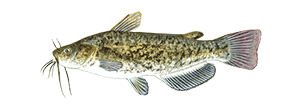Brown Bullhead

Species Details
Ameiurus Nebulosus
Ictaluridae
Siluriformes
Lake, River, Backwater
1 - 5 lbs.
8" - 22"
Brown Bullhead (Ameiurus nebulosus) Description
The Brown Bullhead, another variety of catfish, is known for its mud-brown color hence its name. Like all catfish, it has long barbels that appear like whiskers that allow it to detect food or movement. From the dorsal view, they have a mud brown to dark green gradient which eventually turns a yellowish-white on their belly. Their mouths are slightly facing down, which allows them to do bottom feeding. They also have serrated spines on their dorsal fins which serve as their blades to cut through predators that dare feast on them. And most of all, they don’t have scales. Instead, they have a slimy touch-feel to them which sometimes kills their appeal. Their snake-like appearance also doesn’t make them aesthetically pleasing to some.
The Brown Bullhead also has a black and yellow cousin. However, the difference lies in several things: the color of the barbels, a mark that’s present only at the base of a Black Bullhead’s tail, and the number of rays on their anal fin. A Brown Bullhead’s barbels are yellowish black and don’t have the black bar at the base of their tail. They also have 21-24 anal-fin rays in comparison to the Black Bullhead’s 17-21.
Brown Bullhead Diet
Like all their catfish kind, Brown Bullheads are opportunistic carnivores. Whatever food is thrown their way, they’ll eat it. They’re also known for eating bread, rice, and other small fish. Adult Brown Bullheads also like eating insects such as mayfly larvae, making them also viable for flyfishing. They also have a tendency to eat fish roe, mollusks, plants, worms, leeches, and crayfish.
Brown Bullhead Size
Typically, Brown Bullheads reach up to 20-30 cm. However, there are some cases where Brown Bullheads reach up to 50 cm. This may be because they’re in a swamp. Those in the catfish family function under the same concept: the bigger space they are in, the bigger they allow themselves to grow. And it also helps that they’re not so picky eaters.
Interesting Facts about the Brown Bullhead
- The Brown Bullhead catfish and its cousin aren’t exactly fun to eat.
- These fish aren’t really recommended for children and for fine dining unless you’re really good at flaking fish.
- Those among the Bullhead Catfish family – the Brown Bullhead included – are known to have a lot of bones.
- The barbels of the Brown Bullhead make them hypersensitive to the touch and chemical changes in the water.
- They communicate via soundwaves and also detect proteins that float in the water.
- Their sound production only occurs when they are dealing with an aggressive predator.
- Brown Bullhead catfish are not migratory. They do like to stay in schools, however.
- Brown Bullheads live only up to 6-8 years with an occasional outlier lasting for 9 years.
Brown Bullhead – Fishing Techniques: How to Fish for a Brown Bullhead
First, check the weather. Is it warm? If it is, that raises your chances of catching a Brown Bullhead. The Brown Bullhead catfish loves warm weather. Especially in the first few days of February. Although they can be caught during any time of the year, the warmth raises your chances significantly in securing a good Brown Bullhead.
Next, find a water hole with a muddy bottom in it. Brown Bullheads like muddy waters. They often roam around in swamps. Brown Bullheads are also more active at night. Anglers would recommend using a lantern to help you find them at night.
For equipment, the recommended hook set-up is having a bottom slip-sinker, a bait ring, a size 6-8 hook that has worms, or a chicken liver. Then, let it sink near the bottom. Since they’re bottom feeders, you can have it touch the ground. Make sure it’s not among rocks though.
Brown Bullhead Habitat and Distribution
Brown Bullheads, like other catfish, prefer murky ponds and ditches. They also prefer murky rivers where they can hide. Brown Bullheads prefer slow-moving bodies of water so usually, ponds, lakes, and streams will be the best place to find them. Some have even said that marshes and swamps can be a good place if the water is quite murky.






